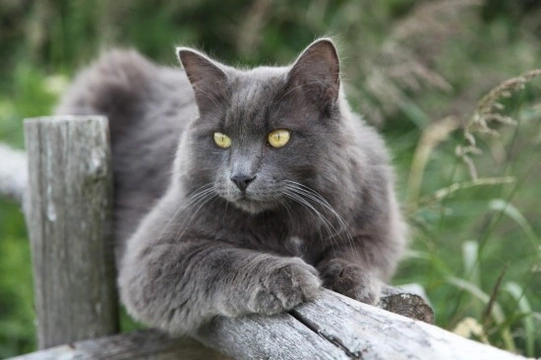
More information on the unusual Nebelung cat
The Nebelung cat is a rare and unusual breed, which was founded in 1984 and so is also a new and very modern breed. Their name comes from a portmanteau of the German words for mist, nebel, and a Germanic saga called “Nibelungenlied.” The Nebelung is long haired with thick, dense fur and is grey-blue in colour, in a shade similar to mist or fog. Their very distinctive and soft coats are their most defining feature.
The breed was created as a variant of the Russian Blue, but with long or semi-long hair, and was created with input from the chief geneticist of the American Cat Association.
TICA, The International Cat Association, was the first formal breed registry to accept and recognise the Nebelung, and to produce the breed standard for cats of the type. The aims of breeding the Nebelung cat is to produce a grey-blue coloured cat with medium long fur that is thick and shimmering, and other than their long fur, similar in many ways to traditional Russian Blue cats from the late 19th and early 20th centuries. Due to their rarity within the UK, the British GCCF has yet to fully recognise the breed.
The cat has a long tail and long body, and is medium sized and muscular. The eyes of the Nebelung can vary between green to yellow, making for a very attractive and also highly distinctive breed of cat.
If you are wondering if a Nebelung is the right cat for you and wish to get a little more information on the breed, in this article we will cover some of the most commonly asked questions about the Nebelung. Read on to learn more.
Do their coats require a lot of care?
The coat of the Nebelung is long and thick, with a top layer of fur and also guard hairs that may be lighter in colour than the main part of the coat. Like most long haired cats, they require regular brushing and grooming, anything from a couple of times per week to almost daily. Because the coat is dense, soft and thick, it is important to groom right down to the roots of the fur, and a wire-pronged brush with blunt ends is generally the best tool with which to do this. Left for too long un-groomed, the Nebelung’s fur may become matted and knotted, particularly around the head and under the belly.
What are their personalities like?
The Nebelung is a kind natured, affectionate cat that is laid back and mild mannered, belying their high levels of intelligence. They are playful, lively and inquisitive, and see closed doors and hidden spaces as challenges to conquer! They like to play and have something to do, and enjoy hunting and simulated hunting games.
They are sweet and highly affectionate with their families and have big personalities, but they do tend to be rather shy or wary around strangers. They bond closely with the people who care for them, and should be homed for life as they do not like being moved around. Some Nebelung owners say that the behaviour of the breed is almost dog-like, and that they will follow their owners from room to room! They thrive on routine and are very clean cats, who will soon let you know if their dining area or litter tray is not to their liking, and they are adept at communicating with people.
Are they healthy?
Because they are a relatively recently established breed, no formal figures are available as yet on the health and longevity of the breed as a whole, but figures submitted by Nebelung owners show a lifespan ranging between 11-16 years.
Health problems that affect their component breeds, such as the Russian Blue, may occur within the breed, but as a hybrid breed, these problems will tend to occur less frequently than within the Russian Blue gene pool as a whole.
Are they good family pets?
The Nebelung will get on well with older children who respect and handle the cat properly, but are unlikely to be happy around small, rowdy children who do not know when to leave the cat alone. When stressed, the Nebelung will tend to retreat and hide rather than becoming defensive.
Are they easy tobuy?
As a recently formed breed and one that is still relatively uncommon within the UK, not many breeders are currently offering Nebelung cats and kittens for sale. If you have your heart set on owning a Nebelung, the chances are that you will have to travel quite some distance to find a breeder, and potentially have to join a waiting list for available kittens.
Because they are both fairly uncommon and also very desirable, the Nebelung is also towards the top end of the price scale for pedigree cats, with kittens of the breed commonly being offered for sale for over £1,000.



